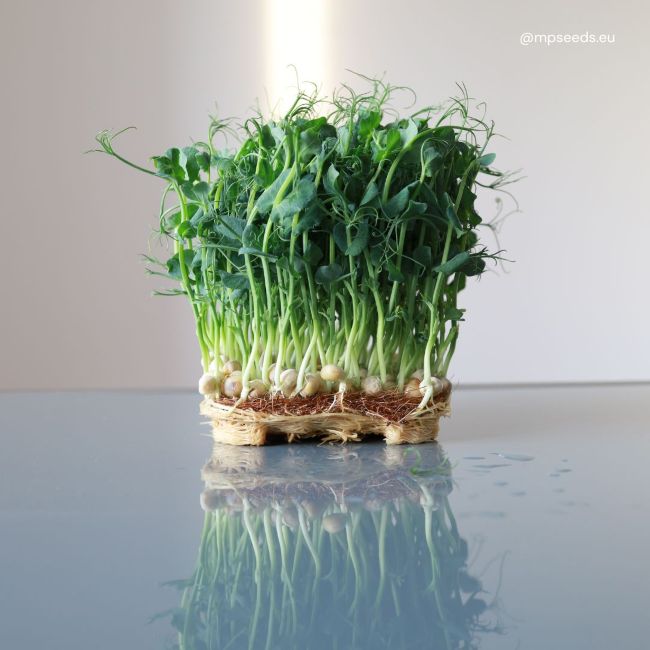What Are Microgreens and Why Are They So Popular

Once a niche trend, microgreens are now a staple in modern kitchens, wellness diets, and small-scale agriculture. But what exactly are they — and why is everyone from home gardeners to Michelin-star chefs obsessed with these miniature plants? In this article, we’ll break down what microgreens are, explore their health and culinary benefits, and explain why they’ve become a symbol of sustainable living.Whether you’re new to the concept or already growing your own trays, you’ll walk away inspired — and maybe ready to start your next harvest. ?
Table of Contents:
- What Are Microgreens?
- Why Are Microgreens So Nutritious?
- How Microgreens Became a Culinary Favorite
- Growing Microgreens at Home or in the City
- Microgreens and Sustainable Living
- Conclusion: Why the Future Is Small and Green

1. What Are Microgreens?
Microgreens are the young, tender seedlings of vegetables, herbs, or edible flowers — harvested just after the first set of true leaves emerges. Unlike sprouts, which are consumed whole including the seed and root, microgreens are grown in soil or growing mats and cut above the root line.
They typically take 7 to 21 days to grow, making them one of the fastest and most rewarding crops for home gardeners and commercial growers alike. Despite their small size, microgreens offer a wide range of colors, textures, and intense flavors — from peppery radish and spicy mustard to sweet pea and nutty sunflower.
With their compact size and vibrant appearance, microgreens (https://mpseeds.eu/microgreens-seeds) are both practical and visually stunning — a perfect combination for today’s health-conscious and aesthetics-driven world.
2. Why Are Microgreens So Nutritious?
Microgreens may be small in size, but they pack an incredible nutritional punch. According to research published by the USDA and the University of Maryland, many microgreen varieties contain significantly higher levels of vitamins and antioxidants compared to their mature counterparts.
These nutrient-dense greens are especially rich in:
- Vitamin K – important for bone health and blood clotting
- Vitamin C – boosts immunity and supports skin health
- Beta-carotene – a precursor to vitamin A, essential for vision and cell growth
- Polyphenols – potent antioxidants linked to reduced inflammation and chronic disease prevention
This makes microgreens not only a colorful addition to your plate, but a functional one too.
2.1 Variety Matters: Different Greens, Different Benefits
Each type of microgreen brings its own unique nutritional profile. For instance:
- Broccoli microgreens are known for their high content of sulforaphane — a compound linked to cancer prevention and liver detoxification.
- Cilantro microgreens provide a generous amount of lutein and beta-carotene, both important for eye health.
- Pea microgreens are a great plant-based source of folate and protein, making them ideal for vegan and vegetarian diets. Explore Seed of all their Varieties: https://mpseeds.eu/pea-shoots
Because microgreens are harvested during a stage of rapid cell division and growth, they concentrate nutrients that would otherwise be spread across a larger, mature plant.

2.2 A Natural Boost Without Supplements
In an age where many people turn to pills and powders for nutritional support, microgreens offer a fresh, whole-food alternative. You don’t need to rely on processed supplements when a handful of freshly grown greens can deliver real, bioavailable nutrients directly to your plate.
They are especially beneficial for people with restricted diets, such as vegetarians, vegans, or individuals on raw food or detox regimens. By incorporating microgreens into smoothies, salads, sandwiches, or warm dishes (added just before serving), you’re fueling your body with live, enzymatically active ingredients.
3. How Microgreens Became a Culinary Favorite
In just a few short years, microgreens have gone from niche garnish to a staple in professional kitchens and gourmet restaurants. Their bold flavors, vibrant colors, and delicate textures make them a favorite tool for chefs looking to elevate both taste and presentation. Unlike many decorative elements, microgreens contribute real, fresh flavor — from the heat of radish to the nuttiness of sunflower.
What started as a fine-dining trend has now filtered down into cafés, meal kits, and even home kitchens, thanks to the growing interest in seasonal, local, and health-conscious eating.
3.1 From Garnish to Key Ingredient
While microgreens were once used only as eye-catching garnishes, they are now fully embraced as integral ingredients in a wide range of dishes. Here are just a few ways they’re being used today:
- Tossed into salads for crunch and color
- Layered on sandwiches and burgers for a fresh twist
- Blended into smoothies for an antioxidant boost
- Sprinkled on soups and risottos for a final pop of texture
- Mixed into dressings, pestos, or dips for extra depth of flavor
Varieties like basil microgreens can intensify classic Italian flavors, while red-veined sorrel adds tangy citrus notes to seafood and vegetarian plates.
3.2 Creative Cooking Starts with Quality Seeds
Chefs know that the foundation of great flavor lies in ingredient quality. That’s why professionals and hobbyists alike trust specialized suppliers when choosing seeds for microgreens. At MP SEEDS, growers can find a curated selection of tested, high-germination microgreen seeds ideal for culinary use — from spicy mustard and colorful amaranth to bold arugula and mellow pea shoots.
Whether you’re running a kitchen or simply want to impress at home, using fresh-grown microgreens adds dimension and professionalism to every dish.
4. Growing Microgreens at Home or in the City
One of the reasons microgreens have become so popular is their incredible accessibility. You don’t need farmland, a greenhouse, or even a balcony — just a sunny windowsill and a little curiosity. For urban dwellers, microgreens are a gateway to homegrown nutrition in the most compact form possible.
This makes them ideal not only for hobbyists, but also for schools, restaurants, and anyone interested in producing food locally and sustainably.
4.1 No Garden? No Problem
Microgreens thrive in small spaces and don’t require complex equipment. Here’s what you need to get started:
- Shallow tray or container with drainage holes
- Growing medium such as soil, coconut coir, or hemp mat
- High-quality seeds (ideally tested and certified for sprouting)
- Light source — either a sunny spot or grow light
Because most varieties are harvested within 7–14 days, you can have a continuous harvest cycle with minimal effort. This makes microgreens one of the most efficient crops for beginners and small-scale growers.
4.2 A Smart First Step into Urban Farming
Growing microgreens is more than a fun DIY project — it’s also a smart introduction to urban agriculture and local food systems. Many growers start with a single tray and expand into a side business supplying microgreens to cafés, caterers, or farmers’ markets.
MP SEEDS supports this journey with bulk seed options, growing accessories, and expert advice for both home and commercial growers. Whether you’re growing for your kitchen or your customers, MP SEEDS offers the tools to succeed from seed to harvest.
5. Microgreens and Sustainable Living
As more people seek ways to reduce their environmental footprint, microgreens have emerged as a surprisingly powerful solution. Their short growth cycle, low resource use, and zero food miles (when grown at home) make them one of the most eco-friendly crops available.
They represent a practical shift toward self-sufficiency, waste reduction, and conscious consumption — three pillars of sustainable living.
5.1 Low Impact, High Return
Compared to traditional farming, growing microgreens requires:
- Up to 90% less water
- Minimal land or space
- No synthetic pesticides or fertilizers
- No need for long-distance transportation
This results in significantly lower carbon emissions and resource depletion. And because microgreens are harvested young, they generate very little food waste — especially when grown just before consumption.
5.2 A Greener Future, One Tray at a Time
Microgreens also support broader sustainability goals. They help reconnect people with the process of growing food, even in urban areas. Schools, restaurants, and community projects are increasingly using microgreens as a teaching tool and as part of local food initiatives.
By encouraging people to grow and eat fresh, seasonal greens, they promote a lifestyle that’s not only healthier — but also more responsible.
6. Conclusion: Why the Future Is Small and Green
From health-conscious foodies to urban farmers and professional chefs, more and more people are turning to microgreens — and it’s easy to see why. These tiny plants offer an impressive mix of nutrition, flavor, convenience, and sustainability, all wrapped in vibrant leaves you can grow almost anywhere.They’re not just a culinary trend or wellness hack — they’re part of a larger movement toward smarter, cleaner, and more self-sufficient living.


